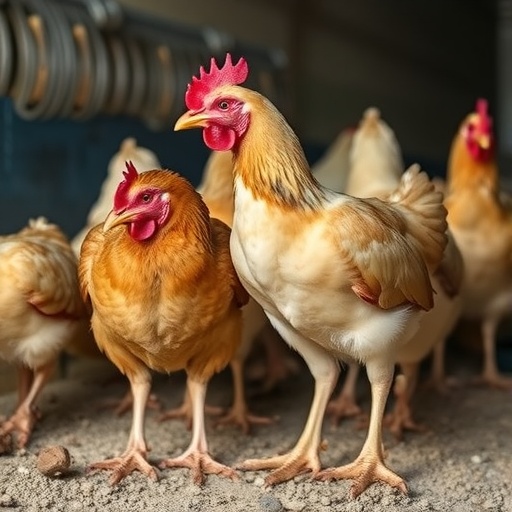Recent research conducted by a team of scientists has unveiled critical insights into the role of selenium in improving the reproductive health of aged broiler breeders. Asghari-Moghadam and colleagues have took a closer look at the specific dietary requirements for selenium, a vital micronutrient, which has often been overlooked in poultry nutrition. The findings could have profound implications for the poultry industry, especially in light of the significant role that reproductive efficiency plays in overall productivity.
Selenium is known for its antioxidant properties and is essential for various physiological processes, including reproduction. The research highlights how precise modeling of selenium intake can lead to improvements in sperm quality, which is particularly vital for older breeder birds. As birds age, their bodies undergo changes that affect fertility, and the introduction of selenium into their diets could counteract these effects. The study opens up new avenues for enhancing male fertility in poultry, a crucial factor for successful breeding operations.
According to the study, the requirement for selenium varies depending on the source from which it is obtained. This insight is particularly groundbreaking, as it challenges the traditional one-size-fits-all approach to nutritional supplementation in poultry. By identifying specific sources of selenium and their respective benefits, the research offers breeders tailored strategies to enhance reproductive performance. This is paramount as it involves not just the integrity of the sperm but also overall flock fertility rates, thus influencing the future production cycles of broiler chickens.
The scientists employed a multifaceted approach, combining laboratory experiments with field studies. This method allowed them to gather comprehensive data on how different selenium sources affect sperm parameters like motility and morphology. The implications of these findings extend beyond immediate poultry health; they present an opportunity for the industry to optimize breeding strategies. Enhanced sperm quality could lead to higher fertilization rates and healthier chick populations, thereby increasing overall productivity and efficiency in broiler farms.
In the pursuit of better poultry habits, the researchers utilized cutting-edge techniques such as in vitro assays and genomic analyses. These methods not only validate the importance of selenium but also illustrate the complexity of nutritional science. Through their analyses, they discovered that the bioavailability of selenium significantly affects how well it works in the body. This revelation points to a need for further research aimed at understanding how various diets can be optimized to improve selenium absorption and effectiveness.
Moreover, the study indicates a direct correlation between selenium supplementation and the reduction of oxidative stress in aged broiler breeders. Oxidative stress can severely impair reproductive health and is a leading cause of infertility. By showing how selenium combats oxidative stress, the research solidifies the necessity for its inclusion in poultry diets, especially for older birds. For breeders and poultry nutritionists, these findings underscore the importance of formulating diets that not only include adequate selenium but also consider its source.
Another fascinating aspect of the research is its potential adaptability. The insights gained are not limited to broiler breeders but can be generalized to other poultry species and potentially different livestock. As the livestock sector faces increasing challenges related to breeding and animal health, incorporating lessons learned from this study could lead to significant advancements across the board. The concept of source-specific modeling could be applied to other essential nutrients, paving the way for a new era in animal agriculture.
Furthermore, the study emphasizes the importance of collaboration between researchers and the poultry industry. The melting pot of academic knowledge and practical application is essential for pushing the envelope on poultry health standards. By sharing findings with poultry producers, this research has the potential to translate into practical guidelines that can be readily adopted on farms, thus ensuring more efficient production systems.
With the global population continuing to rise, the poultry sector is under immense pressure to provide protein-rich foods sustainably. Innovations like targeted selenium supplementation not only enhance animal welfare but also help meet the growing demand for poultry products. This, in turn, can lead to improved food security, an ongoing concern as climate change and other global issues threaten traditional agricultural practices.
In conclusion, the implications of this research are vast and multidimensional. Whether it is improving the fertility rates of aging broiler breeders or addressing broader challenges in the poultry industry, the findings provide a fresh perspective on how nutritional science can be leveraged for practical benefit. As the scientific community continues to delve into the complexities of nutrition, studies like this offer valuable insights that could change the landscape of animal husbandry for years to come.
The research by Asghari-Moghadam and colleagues sets a benchmark for future studies aimed at optimizing poultry nutrition. It highlights the necessity for specific dietary formulations that are scientifically-backed and tailored to the nuances of animal biology. As we look ahead, the insights gained through this work could foster innovation and growth within the poultry industry, ultimately leading to healthier birds and more sustainable farming practices.
The study serves as a reminder that even minor adjustments in diet can produce significant benefits for reproductive health. As poultry breeders look for ways to enhance production and efficiency, understanding the importance of selenium could be the key to unlocking better breeding outcomes. Research like this not only contributes to scientific knowledge but also offers practical solutions that can positively impact food production systems worldwide.
Subject of Research: The role of selenium in enhancing sperm quality in aged broiler breeders.
Article Title: Source-specific modeling of selenium requirements to enhance sperm quality in aged broiler breeders.
Article References:
Asghari-Moghadam, M., Karamzadeh-Dehaghani, A., Behboodi, HR. et al. Source-specific modeling of selenium requirements to enhance sperm quality in aged broiler breeders. Discov Anim 2, 66 (2025). https://doi.org/10.1007/s44338-025-00126-2
Image Credits: AI Generated
DOI:
Keywords: Selenium, poultry nutrition, sperm quality, broiler breeders, reproductive health, oxidative stress.




